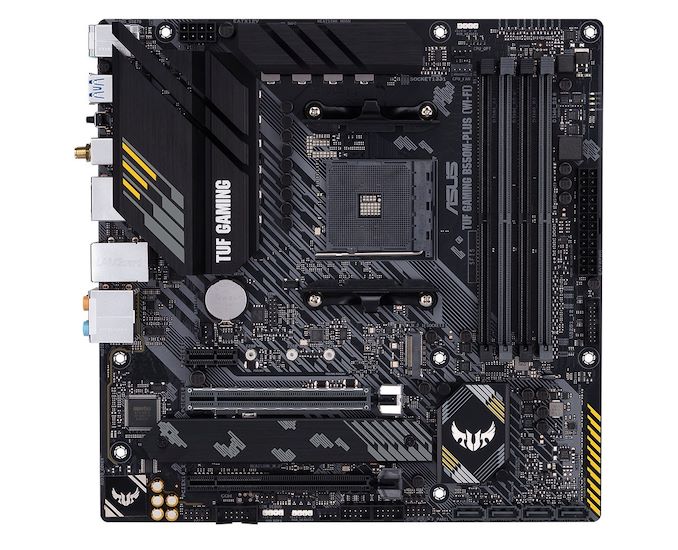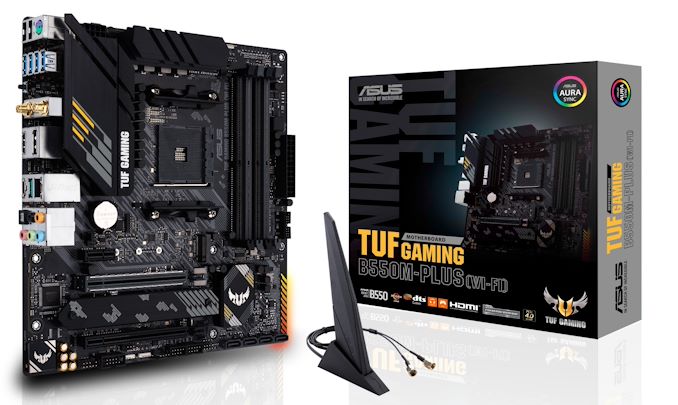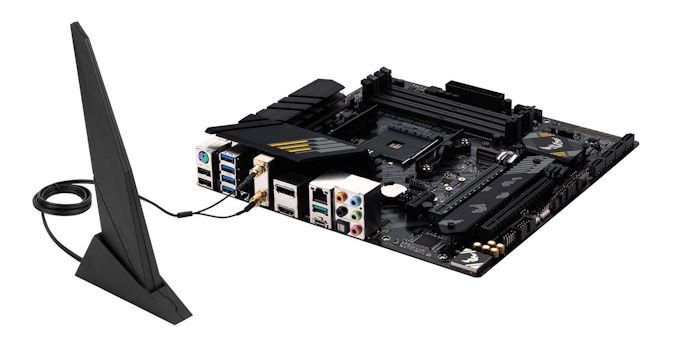The AMD B550 Motherboard Overview: ASUS, GIGABYTE, MSI, ASRock, and Others
by Dr. Ian Cutress & Gavin Bonshor on June 16, 2020 11:00 AM ESTASUS TUF Gaming B550M-Plus + Wi-Fi
For the TUF small form factor board, technically ASUS is going to offer two different models here, one with AX200 Wi-Fi 6 and one without. The price for the B550M-Plus with the Wi-Fi is an extra $20, which is in-line with what we’ve seen from other Wi-Fi 6 variants. At $160 for the base model, it still feels as if this should be on the high-end for a budget chipset, but this is actually around the middle.
The ASUS TUF Gaming B550M-Plus (and Wi-Fi variant) follow similar design cues to the ATX B550-Plus model. It’s a similar styling with grey diagonal lines from top left to bottom right, with some TUF yellow thrown in, and the chipset heatsink covers both sides of the power delivery, but without a heatpipe.
The CPU is powered by a single 8-pin to the top left, and the socket area has access to three 4-pin fan headers within easy reach. The memory slots are all single-sided latch designs, and down the right of the board we get only a 24-pin ATX power connector and a USB 3.0 header. For this board, ASUS has moved all the SATA ports to the bottom of the board! At least in this configuration, it makes removing any of them very easy to do.
The PCIe configuration for the board shows that the top slot is focused on the PCIe 4.0 x4 M.2 slot, without a heatsink so users can have their own. Below this is the main PCIe 4.0 x16 slot, with additional reinforcement. We have then a PCIe 3.0 x4 M.2 slot from the chipset, and a full-length PCIe 3.0 x4 slot from the chipset. The chipset heatsink, like on the B550-Plus is relatively small but should be sufficient.
Along the bottom of the motherboard we get a COM header, RGB LED headers, another 4-pin fan header, two USB 2.0 headers, the front panel header, and the four SATA ports. The audio system uses the same S1200A audio codec as the ROG Strix family, but without the additional amps.
On the rear panel we get a combination PS/2 connector, two USB 2.0 ports, four USB 3.2 Gen 1 ports, a BIOS Flashback button, Wi-Fi ports (for the Wi-Fi model), a DisplayPort, a HDMI port, 2.5 gigabit Ethernet (Realtek RTL8125B), a USB 3.2 Gen 2 Type-A port, a USB 3.2 Gen 2 Type-C port, and the audio jacks.













101 Comments
View All Comments
Operandi - Tuesday, June 16, 2020 - link
Looks like some nice mATX versions this round, nice!YB1064 - Thursday, June 18, 2020 - link
I was hoping to see a $75-$90 board.kenjiwing - Tuesday, June 16, 2020 - link
Fortunately, this component is a unique motherboard among B550 and well worth reading up on [add link].Needs to be edited.
anirudhs - Tuesday, June 16, 2020 - link
There's a noise sensor which can adjust fan speed for maximum quietness with good thermals. Saw it on the KitGuruTech video. The noise sensor isn't there to spy on you though.PeterCollier - Wednesday, June 17, 2020 - link
The quality of the editing here is shit tier. Seriously, just run the articles through Grammarly before publication. It's free and it spots plenty of errors.Heavenly71 - Tuesday, June 16, 2020 - link
Sadly none of the mITX boards have more than 6 external USB ports. My old ASUS mITX has 8! And in really small mITX cases you can't add a bracket with more USB, because the two brackets are already used by the gfx card. Guess I have to wait for an enthusiast mITX board )-:damianrobertjones - Tuesday, June 16, 2020 - link
Or, just maybe, get a usb dongle with 4 ports?Mr Perfect - Tuesday, June 16, 2020 - link
That is disappointing. The number of USB devices people need to plug in can't be dropping, surely? I know I've got more now then even a year ago.rrinker - Tuesday, June 16, 2020 - link
Are they really going up? I have 2 USB devices plugged in to my system - a keyboard and a mouse. I occasionally plug a USB stick in one of the front ports to transfer files. My phone and tablet sync over wifi, they don't get plugged in. I have a charger behind my desk and a cable to charge them. My printer is on the network.The one place I DO need lots of USB ports is also the place where I have a small cube case machine, with no discreete GPU, because it doesn;t need one. On that one I added a USB PCI card to get enough ports. In addition to the keyboard and mouse, that machine is on my workbench where it connects to several electronic test instruments and I have multiple cabled for programming microcontrollers. I also have a USB microscope for board inspection. And then I have 3 more USB devices connected for my other hobby that shares the bench. Plus a front port kept free for USB sticks.
So the use case I have for more USB has the PCI slots open to add expansion cards, the use case where I have a discrete GPU eating up the slot space doesn't need an excess of USB ports.
DigitalFreak - Tuesday, June 16, 2020 - link
I use 3 USB 3.0 ports just for my Oculus Rift